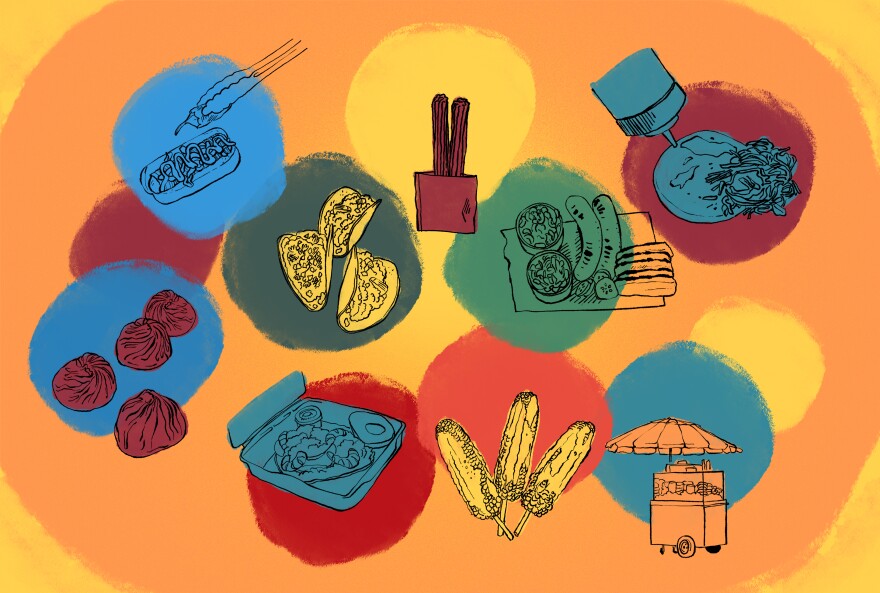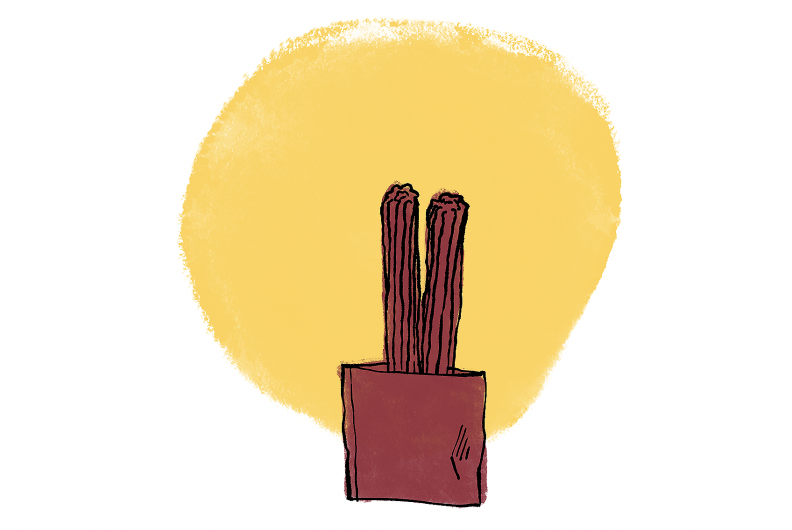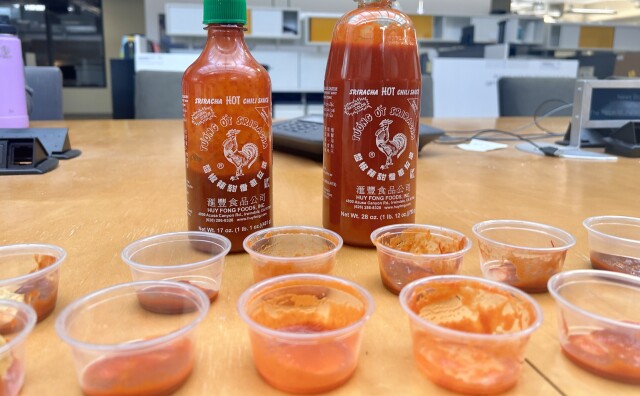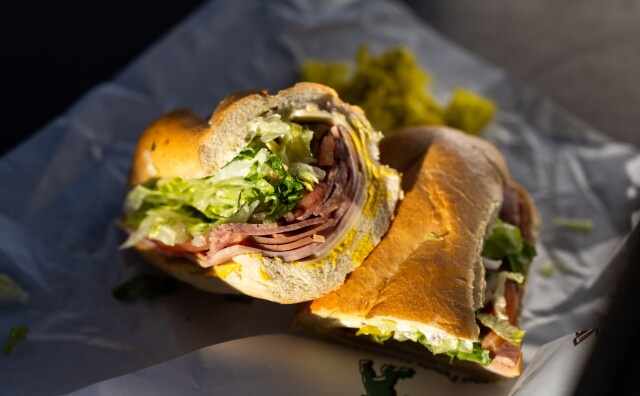Get A Taste Of LA With These Street Food Essentials

Street food in Los Angeles is a source of life. It defines the city and its beautiful characteristics, highlighting the diversity of the myriad cultures that call the area home. We’ve put together a list of some classic L.A. street food staples to help guide your hungry stomach for a taste of what our great city has to offer.
From delicious tacos to juicy soup dumplings to piled-high bacon-wrapped hot dogs, the street food of Los Angeles can fit almost every set of taste buds.
Happy eating.
Bacon-Wrapped Hotdog AKA Street Dog, L.A. Dog

Where it came from:
It’s hard to pinpoint when exactly the bacon-wrapped hot dog rose to prominence. Still, many argue it was sometime during the 1980s with the influx of Mexican immigrants, taking cues from its southwestern cousin, the Sonora Dog, which is also bacon-wrapped.
Classic elements:
Bacon-wrapped Hoffy hot dog, classic bun (no brioche here), large pieces of white or yellow grilled onions, green bell pepper, ketchup, mustard, mayo, and topped with a whole grilled jalapeño laid on top. Triple points if you get all of the contents of the dog in one single bite.
Bottom line:
What’s not to love is more like it? The L.A. dog is there when you need it the most, whether leaving a concert or sporting event, to provide sustenance as part of a quintessential culinary experience in our city.
We don’t love that L.A. dogs are considered illegal street food because their cooking methods use a makeshift flat top grill, making it the unfair poster child of illegal street food persecution. However, to satisfy those late-night cravings, we challenge those in authority to find a dish that more Angelenos can get behind, especially in a drunken huddle, to meet those late-night cravings.
Where to find it:
While addresses are hard to come by when it comes to tracking the dogs themselves, you are better off heading to an area where large events take place and look for the little red carts with the wafting smoke billowing out; only then will you know you are in the right place.
Elote

Where it came from:
Originated from Mexico City, known for its street food, then later brought to the U.S., it gained popularity amongst Angelenos.
Classic elements:
Corn on the cob, butter, mayonnaise, cotija cheese, and chile powder
Bottom line:
Elote is a perfect snack for enjoying on-the-go, as often is the case when the stick handle is attached to the cob itself, making it mobile for any situation. Getting your elote from an actual elotero is also a pro-move. They will often cruise neighborhood streets, honking a bike horn and alerting everyone within earshot that it is, in fact, elote time.
Are you looking for something different? Try esquites: loose corn kernels cooked with butter and various herbs, such as cilantro or epazote, salt, lime juice, red chile salsa, Mexican cream, mayonnaise and cotija cheese, all mixed well in a lovely corn salad.
Where to find it:
Corn Man: 2338 Workman St., Los Angeles, CA 90031 (Lincoln Heights)
El Mercadito: 3425 1st St., Los Angeles, CA 90063 (Boyle Heights)
Tacos

Where they came from:
The taco, as many might know, originates from Aztec times. The word taco comes from the Nahuatl word “tlahco,” which means “half or in the middle,” referring to how it’s formed — eventually evolving to include different types of meat that immigrants brought from Europe.
By the mid-1930s, tacos began to take prominence in Los Angeles, with the opening of Olvera Street. As street food, tacos weren’t still entirely accepted, especially from Mexican-owned food establishments. As fast food began to expand throughout the greater L.A. area, places such as Taco Bell became commonplace in the '50s and '60s. Much later, the rise of mobile trucks made tacos a street food in L.A.
Classic elements:
Tortilla (corn or flour), protein of your choice (beef, chicken, fish, shrimp, pork, lamb, grasshopper), vegetables, salsa
Bottom line:
Tacos are an essential part of street food in Los Angeles and Mexico.
Where to find them:
Chances are there is a taco truck or stand within a mile radius from you are at this exact moment. With that said, these are some of our current favorites:
Macheen; 2633 East Cesar E Chavez Ave., Los Angeles, CA 90033
El Ruso: 3140 Sunset Blvd., Los Angeles, CA 90026
Carnitas El Artista: 510 N La Brea Ave., Inglewood, CA 90301
Fruit cart

Where it came from:
With the availability of year-round fresh produce coming from around the state and Latin America, futeros — or fruit carts — became part of L.A. culture, occupying street corners just about everywhere you look.
Classic elements:
Mango, papaya, watermelon, coconut, cucumber, pineapple, orange, tajin, chamoy, and lime juice.
Bottom line:
The idea of having fresh fruit at a fraction of the price it might regularly cost at a place such as Whole Foods and Erewhon is a no-brainer. In addition, we love seeing the multi-colored rainbow umbrella that serves as the calling card for almost every fruit stand, giving that pop of color to our coastal desert landscape.
Where to find it:
La Frutería: 317 S. Broadway, Los Angeles, CA 90013
Joe Mendez's Fruit Stand: 600 S Oxford Ave., Los Angeles, CA 90010
Churros

Where they came from:
Originating in China from a street food known as youtiao, a long, salted fried donut typically at breakfast. Found in various forms throughout Asian cultures, it makes its way to Spain via Portuguese colonizers. The churro can vary in length and shape because of the extruded method used when first adopted. Found throughout Latin America and eventually makes its way to the United States via Mexico, with sugar replacing the salt.
Classic elements:
Taking on various forms, often rolled in cinnamon sugar-encased ridges, and sometimes filled with chocolate or canela.
Bottom line:
The beauty lies in the ability to enjoy churros anytime and anywhere, from theme parks to sharing a bag with friends along the street; churros will always be there to enjoy.
Where to find them:
Churros Don Abel: 5468 Whittier Blvd., East Los Angeles, CA 90022
LA Churros: 700 S Western Ave., Los Angeles, C, 90005 (Koreatown)
Xiao long bao

Where it came from:
In Los Angeles, dumplings aren’t on every street corner per se, that doesn't mean their popularity is any less essential to the local culinary landscape. The most popular in recent decades is the xiao long bao or xlb , a soup dumpling steamed in a bamboo basket packed with juicy bits of ground pork and wrapped in a soft dough.
Xlb originates from Changzhou, in the Jiangsu province in the mid-1800s, eventually making its way to NYC and Los Angeles in the '90s and 2000s due to the influx of Chinese immigrants.
Classic elements:
The hand-folded dumpling wrapper includes either chicken or pork mixed with an aspic which, once steamed, melts down in a soup-like broth when consumed.
Bottom line:
Each juicy bite of an xlb dumpling delivers absolute comfort. Slurping dumplings makes for another excellent meal experience to share with friends and loved ones.
Where to find them:
Din Tai Fung: Various Locations
Mason’s Dumplings-: 5803 N Figueroa St., Los Angeles, CA 90042
Ceviche

Where it came from:
Ceviche is Peruvian in origin, with roots that trace back to the Incas. Before the Spanish brought citrus, the Incas used passion fruits from the Amazon rainforest to marinate fish. Slowly, ceviche caught on and made its way through Latin America and the Caribbean, taking on different forms and flavors. The recipe was modified over time with the help of Japanese immigrants to help streamline the marinated process in the 1970s.
Classic elements:
Various mariscos (fish, shrimp, octopus, etc.) marinated with salt, lime, chile.
Bottom line:
The fresh seafood dish enjoyed on-the-go from some of the legendary mariscos trucks around the city makes for a quintessential experience of being an Angeleno.
Where to find them:
Mariscos El Faro: 6139 N Figueroa St. # 6113, Los Angeles, CA, 90042
106 Seafood Underground: 4302 W 106th St., Inglewood, CA 90304
Mariscos Jalisco: various locations
Pupusas

Where they came from:
Coming to prominence in Los Angeles, as many Salvadorans moved here in the 1980s, pupusas became synonymous with street food as small stands began to pop up in and around the city.
Classic elements:
A thick handmade corn flour tortilla stuffed with cheese, refried beans, chicharrón (pork), served with a lightly fermented slaw known as curdito, a light tomato salsa.
Bottom line:
Tearing into a pupusa and getting that first bite of masa and cheese topped high with curdito, containing the right amount of tartness along with the light spice from tomato salsa, makes for an extremely satisfying experience. So much that it is easy to devour all in just a few bites; the only downside is that we wish we had more, so bring a friend so you can steal a few bites from them.
Where to find them:
Sarita's Pupuseria: 317 S. Broadway, Downtown Los Angeles
Paseo San Miguel: Various locations
BBQ

Where it came from:
Grilled meats are a mainstay for many, especially during large at-home gatherings such as the Super Bowl. Luckily, L.A. boasts many BBQ establishments that regularly pop up to take some of the work out of the usually painstaking process.
Classic elements:
Brisket, sausage, ribs, chicken, pulled pork, and various sides including mac and cheese, greens, coleslaw, potato salad and cornbread, along with your favorite sauce.
Bottom line:
With the rising cost of beef, quality BBQ can come with a hefty price point, another reason to grab a large platter of the grilled good stuff, and even more reason to share with a group of friends.
Where to find it:
Woody's Bar-B-Q: 475 S Market St., Inglewood, CA 90301
The Wood Urban Kitchen: 129 N Market St., Inglewood, CA 90301
-
After people began complaining online that Sriracha they'd bought recently didn't taste like the old stuff, we set out to find the answer. It didn't go well.
-
From tortas to tuna melts, all sandwiches tell a unique story as they celebrate Los Angeles' diverse tapestry of flavors with each bite.
-
The company behind Sriracha told us production has resumed.
-
Dustin Bartz has figured out a way to sell a $6 smashburger — and still make a tidy profit. He enjoys trolling competitors who charge more.
-
Two amateur bakers take on a beloved, almost sacrosanct school treasure.
-
For Jeff Alulis, the Burger Quest became “something bigger” than him.









